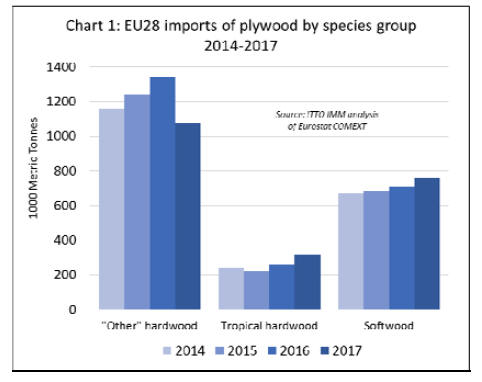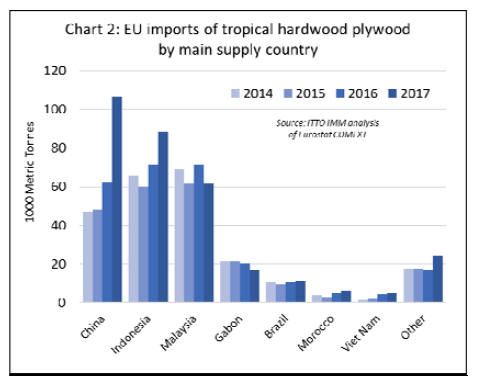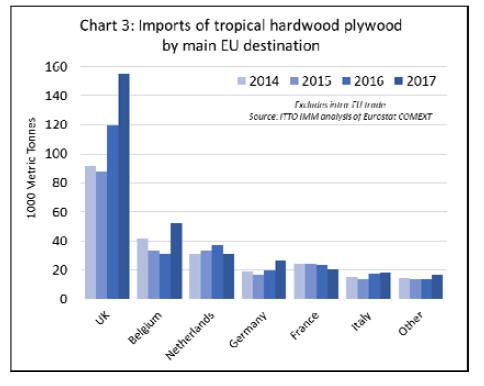|
Report from
Europe
Rising demand and limited supply push plywood
prices
Plywood prices are rising sharply in the EU on the back of
buoyant demand across the region and supply issues in a
range of key exporting countries.
There is also now an increasing tendency to order more
just-in-time, little and often to hedge against the risk of the
present ¡®market bubble¡¯ bursting.
That summarises recent feedback from leading European
plywood importers and distributors on trade and market
trends.
One leading player described market dynamics over the
last six months as ¡®increasingly tricky¡¯. It had reached the
point where, due to constrained supply and competition for
what supply there was, the company was now effectively
rationing product.
¡°There¡¯s certainly no need for advertising currently ¨C
everything we¡¯re bringing in is already sold,¡± he said. ¡°In
fact, we¡¯re allocating product to a waiting list, with loyal,
long-term customers obviously at the front of the queue.¡±
Adding to market challenges, importers say they have had
to become ever more selective in choice of supplier in
response to what they describe as increasingly stringent
and more uniform application of the EU Timber
Regulation (EUTR).
¡°This and our own increasingly strict corporate social
responsibility policy and stress on minimising reputational
risk means that, where we previously had 10-15 suppliers,
we now have just four or five who we know we can rely
on to consistently satisfy our due diligence requirements,¡±
said another importer. But clearly that potentially
exacerbates availability issues when supply is tight
generally.
Descriptions of price rises resulting from this combination
of market pressures range from ¡®significant¡¯ to ¡®seismic¡¯.
A UK importer said in the last six months they¡¯ve seen
prices for Malaysian and Chinese tropical plywood
increase 25% and 20% respectively, while Brazilian
elliottii is up 30%.
A continental European buyer said they¡¯d seen an even
steeper hike in the cost of elliottii pine plywood since last
June. ¡°Then we were paying US$240/245 per cu.m fob for
standard 20mm C+C, now we¡¯re at US$330,¡± they said.
¡°We¡¯ve been cushioned to an extent by the weakening of
the dollar, which nine months ago was at euro1.06 and is
now euro1.23. But even so, a rise of US$80 per cubic
meter is a lot to take on board ¨C and if the dollar
strengthens, we¡¯ll be in for even stiffer rises. Larger
customers with a more global perspective understand the
situation and accept they have to pay more, but efforts to
pass on at least some of the increases to smaller businesses
are meeting with resistance.¡±
The main driver for EU demand of both tropical and
temperate hardwood and coniferous plywood is continuing
construction growth across much of the EU, particularly,
according to one international importer/trader, in north
west European countries where a relatively mild winter
has meant the market has remained more active than usual
at this time of year.
The latest report from Euroconstruct forecast 2017
construction growth in its 19 focus countries at 3.5%. It
added that it was the first time there had been an ¡®across
the board¡¯ increase in activity in all countries since 1989,
and that growth in a basket of construction market
measures was at its highest since 2006.
The result, say suppliers is healthy demand for everything
from shuttering/formwork plywood, to top end structural
and exterior grades.
Furthermore, Euroconstruct predicts that the EU building
sector will see another 6% expansion by 2020, with civil
engineering projects and refurbishment and maintenance
sectors taking over from residential and non-residential
building in providing most market momentum.
But - Risk of overheating plywood market
For the immediate future, the EU plywood sector sees
little change in trading conditions. Further ahead,
however, the picture is less certain. ¡°There are now signs
of the market overheating, and at some point there will be
a correction,¡± said an importer distributor.
¡°I don¡¯t see it in the next six months but, if US buyers exit
the Brazilian market, as we¡¯ve seen happen before, our
other leading global suppliers raise output and demand
comes off current levels, we could be looking at a very
different market scenario from the fall onwards. Leading
up to this point I think we¡¯re already seeing more cautious,
hand to mouth purchasing so companies aren¡¯t overexposed.¡±
Buoyant EU economy
EU building growth is underpinned by generally buoyant
economic performance and this, in turn, says the plywood
sector, is fuelling sales rises in other markets, notably
packaging and furniture.
Demand in the latter is reported being given added
impetus by a design trend to use plywood as the sole
manufacturing material, with faces and edges expressed,
even unfinished, to reveal its structure and achieve an
¡®industrial look¡¯. Birch is the favoured species here, but
one leading kitchen maker said they were also exploring
the use of darker-faced tropical varieties.
Against this bullish economic backdrop, latest EU
plywood import statistics make clear why the market
generally is reporting a squeeze on supply. Imports didn¡¯t
just fail to keep up with demand last year, they declined.
EU plywood imports down 7% in 2017
Total EU plywood imports in 2017 were down 7% to
2.159 million metric tonnes (MT). This was due entirely to
contraction in the ¡®other hardwood¡¯ plywood category,
with imports down over 20% from 1.346 million MT to
1.076 million MT.
Part of this was likely due to a revision of customs product
codes in 2017, which saw a large number of species
previously labelled ¡®other hardwoods¡¯ now identified as
¡®tropical¡¯.
However, this was clearly not the only factor in the
downturn, as tropical and softwood plywood imports
increased by a combined total of only 115,000 MT in
2017; the former rising from 262,000 MT to 320,000 MT,
the latter from 707,000 MT to 760,000 MT. (Chart 1)

Overtaking both Indonesia and Malaysia as the largest
supplier of tropical hardwood to the EU was China, with
imports up 44,000 MT to 106,000 MT in 2017. This is
almost entirely due to the HS product code
reclassification, as Chinese ¡®mixed red hardwood¡¯
plywood was most affected.
EU imports of Indonesian plywood were ahead 24% in
2017, rising from 71,000 MT to 88,000 MT, while imports
of Malaysian plywood dipped 15% from 71,000 MT to
62,000 MT, and imports of Gabon plywood fell 19% from
21,000 MT to 17,000 MT. (Chart 2).

The largest EU tropical plywood importer in 2017
remained the UK, which increased its purchases by 29%
from 120,000 MT to 155,000 MT.
Belgium became the second biggest, with imports rising
21,000 MT to 52,000 MT, taking over from the
Netherlands where imports fell 6,000 MT to 31,000 MT.
Germany also saw an increase of 35% to 27,000 MT in
2017. (Chart 3).

FLEGT licensing and plywood demand
The extent to which the start of FLEGT licensing in
November 2016 played a part in Indonesia¡¯s EU export
growth last year is a matter of debate, but the consensus
amongst importers seems to be that it was one of several
factors and it is now becoming more important.
One importer said the availability of third-party quality
assured marine plywood from Indonesian producers was
more of a factor in their increased imports. But another
said they had ¡°switched sourcing to Indonesia to a degree¡±
due to the availability of FLEGT licensed material and the
savings in administrative time and cost on EUTR due
diligence involved.
Meanwhile, a Belgian importer distributor saw a FLEGT
licence becoming an increasingly valuable reputational
guarantee. He suggested that EUTR monitoring and
enforcement activity are growing, led by the national
competent authorities (CAs) of Germany, the UK,
Netherlands and Denmark, and to a degree France, and
with others just beginning to step up capacity to undertake
more checks, including in Belgium.
This importer also suggested that there¡¯s now greater
operational collaboration and intelligence sharing between
CAs. ¡°It¡¯s got to the point where companies like ours are
adopting a zero-tolerance policy on risk of any illegal
material entering our supply chain. If we have any doubts
about a supplier, species or source of supply, we won¡¯t use
them¡±, he said.
He went on, ¡°in that context a product backed by a
FLEGT licence as proof of legality clearly is set to
become an increasingly attractive option.¡±
Multiple plywood supply constraints
EU plywood importers suggest that recent trends in
imports have been driven as much by supply side issues as
by changes in European consumption. Supply constraints
have been mounting in the last six months.
According to one importer, the severe rainy season in
Indonesia was an important factor limiting supply of
tropical hardwood plywood last year. Harvesting was
impacted and mills were running increasingly short of raw
material.
¡°Indonesia may have increased its exports to the EU
overall last year, but more recently we¡¯ve been getting as
little as 50% of normal deliveries,¡± said the company.
¡°Many mills must be losing money and some have gone
on to short-time, or mothballed production.¡±
This importer was hoping that the rainy season will finish,
as normal, end of March. ¡°But last year that didn¡¯t
happen,¡± said another importer. ¡°Some feel it¡¯s another
possible sign of climate change. It maybe we¡¯re facing
more unpredictable weather patterns generally and our
industry will just have to adapt.¡±
Chinese environmental regulation reduces plywood
supply
EU plywood importers also report that production output
of their Chinese suppliers is being affected by tough new
environmental and health and safety regulations. This has
forced Chinese producers to invest heavily in new
production and pollution control technology. Some have
cut or even stopped production while installation work
goes on.
¡°The new rules are also driving many of the small-scale,
family-run, rotary cut veneer plywood manufacturers out
of business,¡± said an importer. ¡°They principally served
the domestic market, so now domestic customers are also
turning to the bigger export producers, adding another
supply pressure.¡±
Chinese producers looking for higher prices
It¡¯s generally agreed that the main pressure on elliottii
supply has been rising global demand. Brazilian mills last
year were reported to have topped 2 million cubic metres
in output last year, but EU importers say their US
counterparts have been buying particularly heavily, and
demand elsewhere in the region has also risen, including
in Mexico and Caribbean markets.
¡°Add in freight rate rises, and that¡¯s why elliottii has
become an increasingly costly commodity,¡± said one EU
importer.
Weather is cited as a factor in recent Russian supply
trends. A slow start to the winter, is reported to have
delayed harvesting, leading to a backlog of orders. ¡°Now
mills are sold quite well ahead, with order books full for
March and April,¡± said an EU importer. ¡°We anticipate a
price uptick as a result.¡±
EU associations push for higher plywood quality
standards
Timber trade associations in two leading EU importing
countries have recently been pushing forward plywood
quality, performance and legality initiatives.
In the UK, the Timber Trade Federation (TTF) has
undertaken a Plywood Review over the last 18 months.
This is in response to concerns over import of products,
mainly from China, that the TTF claims do not meet key
EU/UK legal compliance legislation.
That included products classified as high risk under the
EUTR not being adequately risk mitigated through tropical
veneer species testing. The initiative was also in response
to insufficient glue-bond testing being undertaken, notably
in EN.314 Class 2 product, to be able to draw up a
Declaration of Performance (DoP).
The TTF has liaised with Chinese trade associations on
these issues and produced recommendations for members.
These include; for EUTR compliance, to implement
regular plywood species testing from high-risk suppliers;
to provide clear species marking on packs; and to ensure
suppliers operate documented Factory Production Control
(FPC) in compliance with the EU Construction Products
Regulation.
The TTF said the review is ongoing and will be subject to
more discussion and actions in coming weeks.
In Germany, GD Holz has been continuing to develop its
Plywood Quality Initiative (Initiative Qualitäts Sperrholz
/IQS). With five member importers, and aims to include
more, the focus is on ¡®ensuring correct description of all
product characteristics and properties¡¯.
The companies are obliged to ensure suppliers meet
national product codes and to include all relevant product
technical details and descriptions with deliveries.
Recently GD Holz has issued a leaflet to inform members¡¯
customers what to expect from an IQS supplier and a
brochure detailing softwood and hardwood plywood
production codes of Brazil (ABNT), Russia (GOST),
Finland (SFS) and the EU (DIN-EN).
Currently IQS is concentrated on technical issues, but it
intends eventually to add legality and sustainability to its
remit.
|